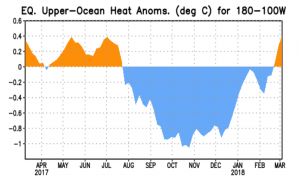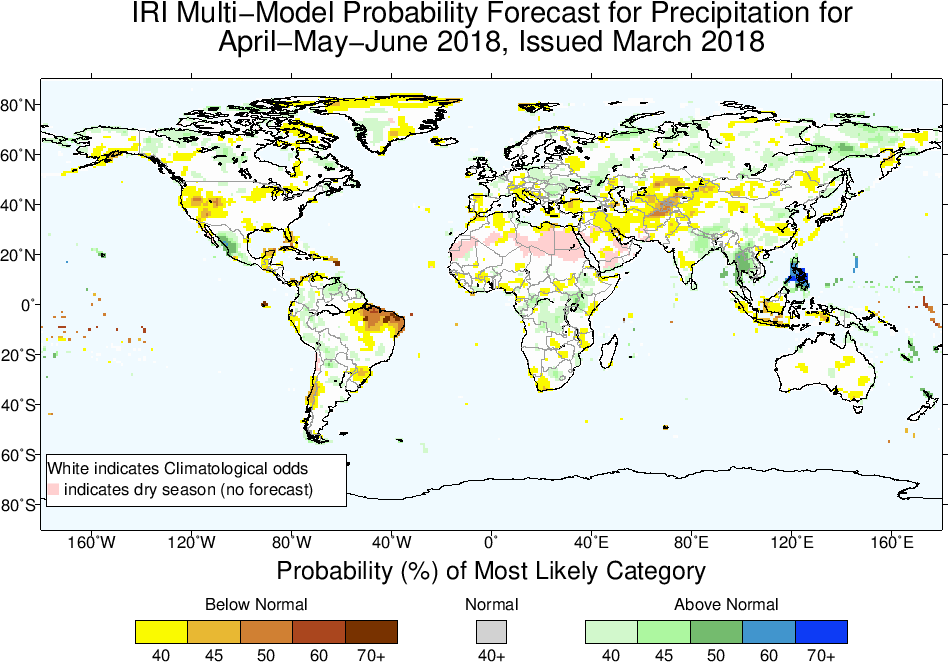March Climate Briefing: Last Gasp of La Niña Influence
Read our ENSO Essentials & Impacts pages for more about El Niño and La Niña.
What’s New
Sea-surface temperature (SST) anomalies in the equatorial Pacific Ocean are trending warmer since last month’s briefing, but they remain in the La Niña realm. Weekly SST anomalies in the area of the Pacific that helps define El Niño and La Niña events, called the Nino3.4 region, averaged -0.83ºC over the last four weeks, which falls in the category of a weak La Niña state. For the previous four weeks, the Nino3.4 anomaly was -0.9ºC.
Sub-surface ocean temperatures have also continued to warm (see second figure below). These sub-surface conditions are often a preview of what’s to come at the surface, so it’s likely that La Niña conditions at the surface will diminish in the next month.

The sea-surface temperatures in the Nino3.4 region (approximated here) serve as a primary metric of El Niño and La Niña conditions. Data from the IRI Data Library. Image: IRI/Elisabeth Gawthrop

Temperature anomalies taken of the upper sub-surface ocean in the equatorial Pacific. Measurement taken from 180-100ºW, and from the surface to 300 meters deep. Source: NOAA.
Because IRI and the National Oceanic and Atmospheric Administration’s Climate Prediction Center predict that La Niña will continue for now, the ENSO alert level remains at a La Niña Advisory, which was initially issued in November.
ENSO Forecasts
To predict ENSO conditions, computers model the SSTs in the Nino3.4 region over the next several months. The plume graph below shows the outputs of these models, some of which use equations based on our physical understanding of the system (called dynamical models), and some of which use statistics, based on the long record of historical observations.
With the exception of one model, all of the models in this month’s forecast predict SST anomalies in Nino3.4 to gradually warm through the year. The means of both types of models are topping out at or just under the +0.5º El Niño SST threshold during late 2018. This represents a slight decrease in maximum SST predicted by the dynamical models compared to last month’s prediction, and an increase for the same measure from the statistical models.
Just as last month, the model means both show SSTs crossing into neutral ENSO territory by the March-May season.

Based on the model outputs, odds for La Niña conditions and neutral ENSO conditions are even at 50% for the current March-May season. Neutral conditions then take over as the most likely ENSO state through the northern hemisphere summer. In the October – December season, El Niño becomes the most likely condition, but chances are still under 50% and uncertainty is high.
ENSO in context: Resource page on climate variability
The official probabilistic forecast issued by CPC and IRI in early March indicates similar overall trends in ENSO probabilities, but with slightly less likelihood of El Niño in the later months. This early-March forecast uses human judgement in addition to model output, while the mid-month forecast relies solely on model output. More on the difference between these forecasts in this IRI Medium post.
IRI’s Global Seasonal Forecasts
Each month, IRI issues seasonal climate forecasts for the entire globe. These forecasts take into account the latest model outputs and indicate which areas are more likely to see above- or below-normal temperatures and precipitation.

For the upcoming April – June season, odds are moderately to strongly tipped in favor of above-normal rainfall in the Philippines and parts of mainland Southeast Asia. Areas with a tilt of the odds towards below normal precipitation include Indonesia, western U.S., northeastern Brazil and central Asia.
All forecast maps, including temperature in addition to precipitation, and including methodologies, are available on our seasonal forecast page.
Learn more about El Niño and La Niña on our ENSO resources page, and sign up here to get notified when the next forecast is issued. In the meantime, check out #IRIforecast.


You must be logged in to post a comment.